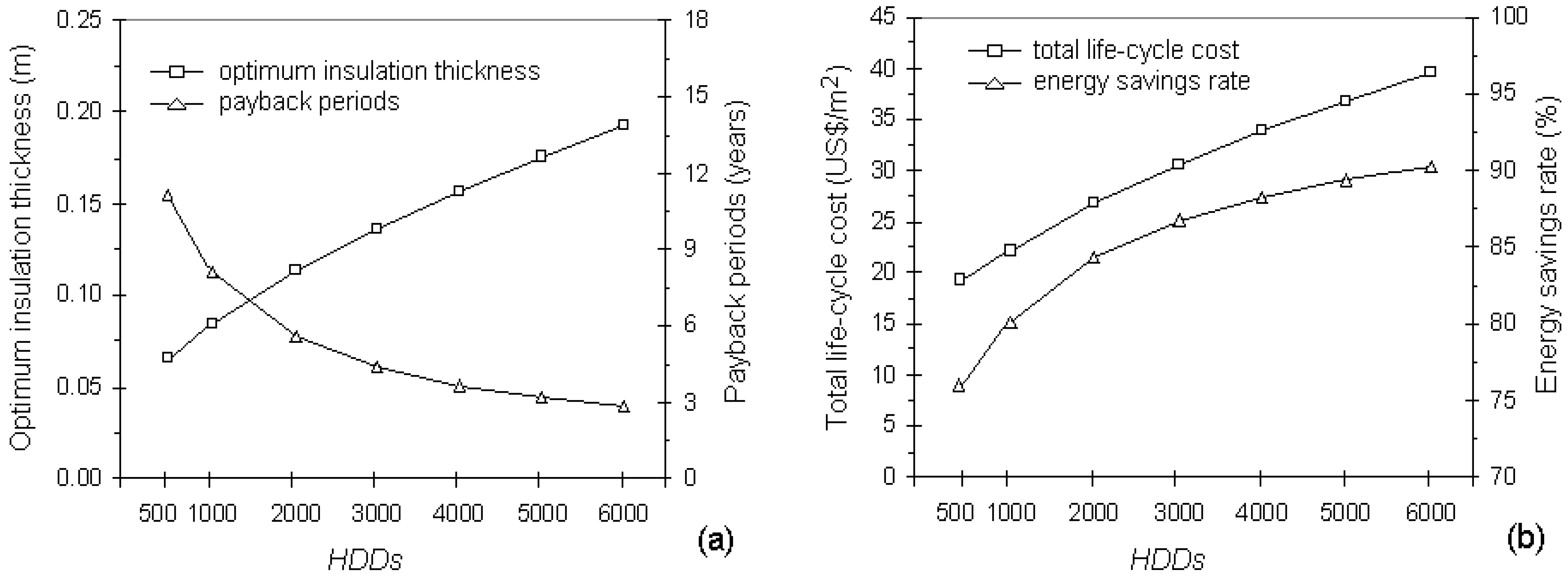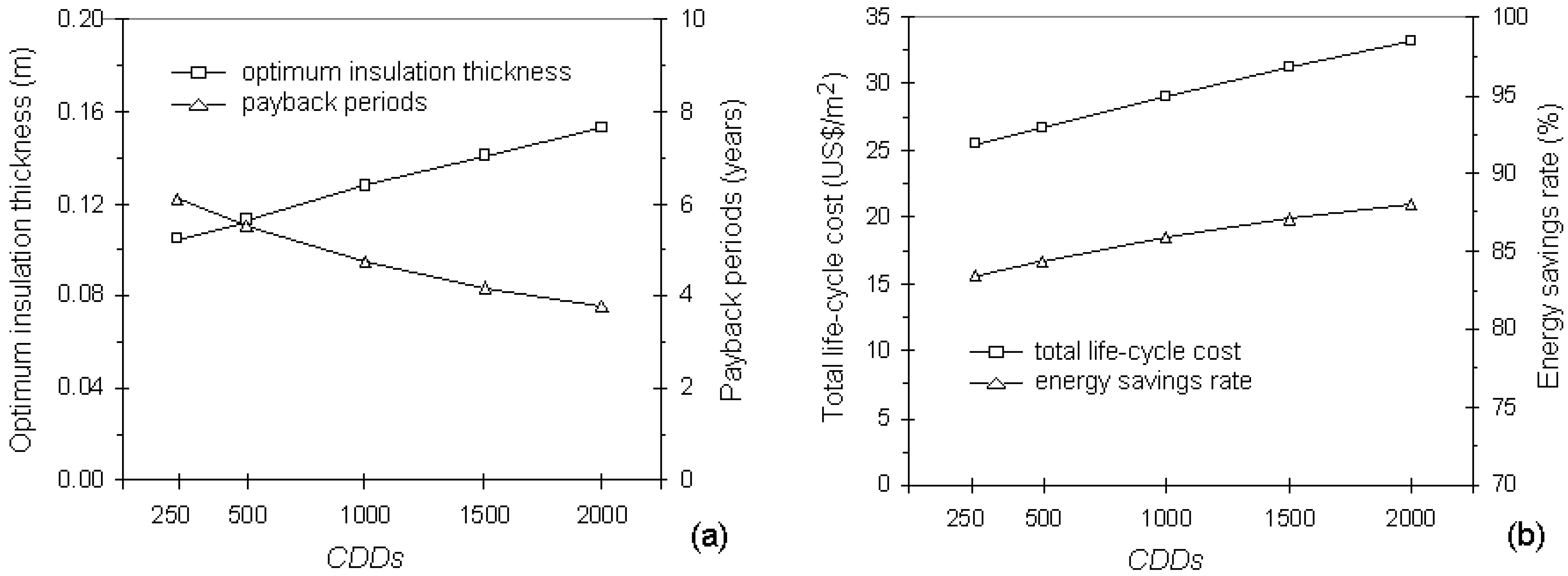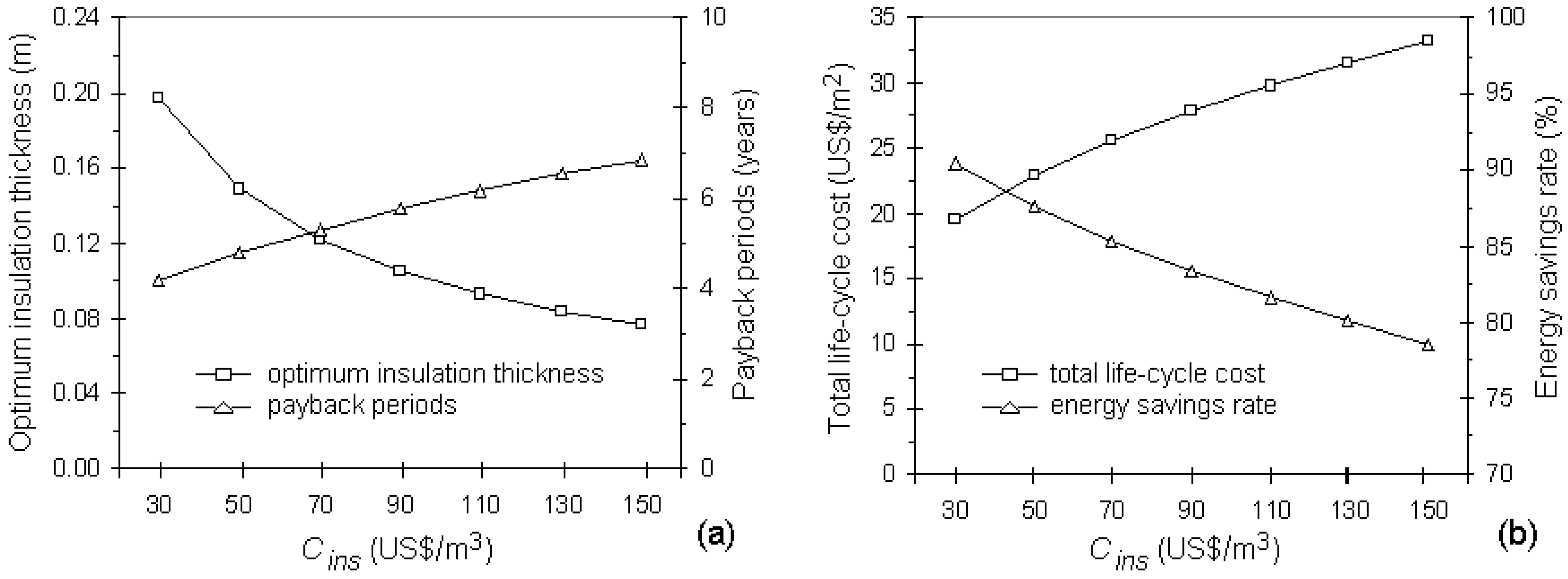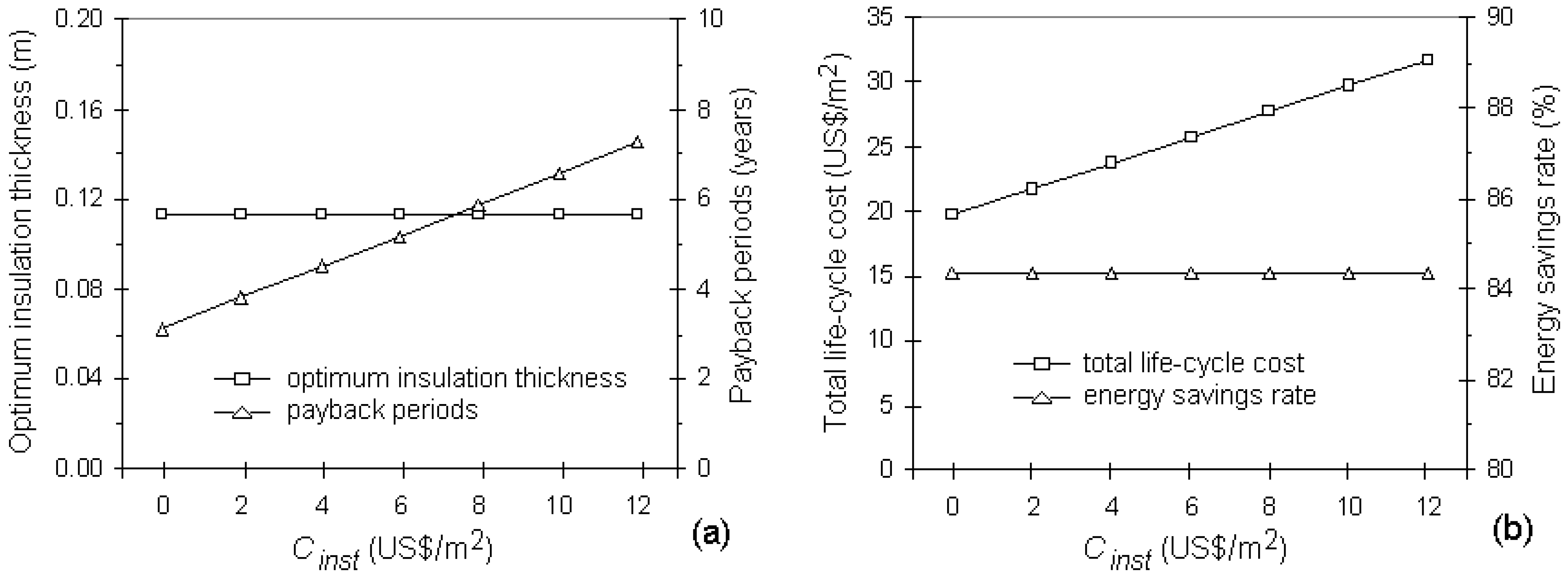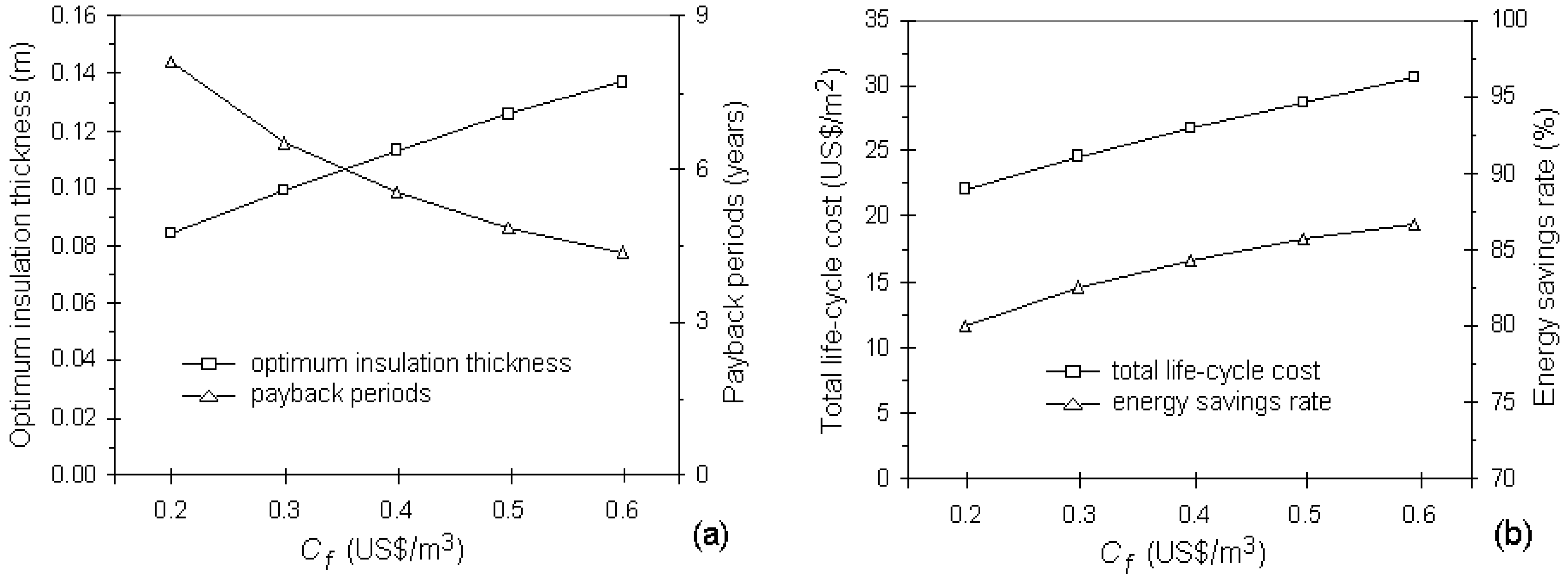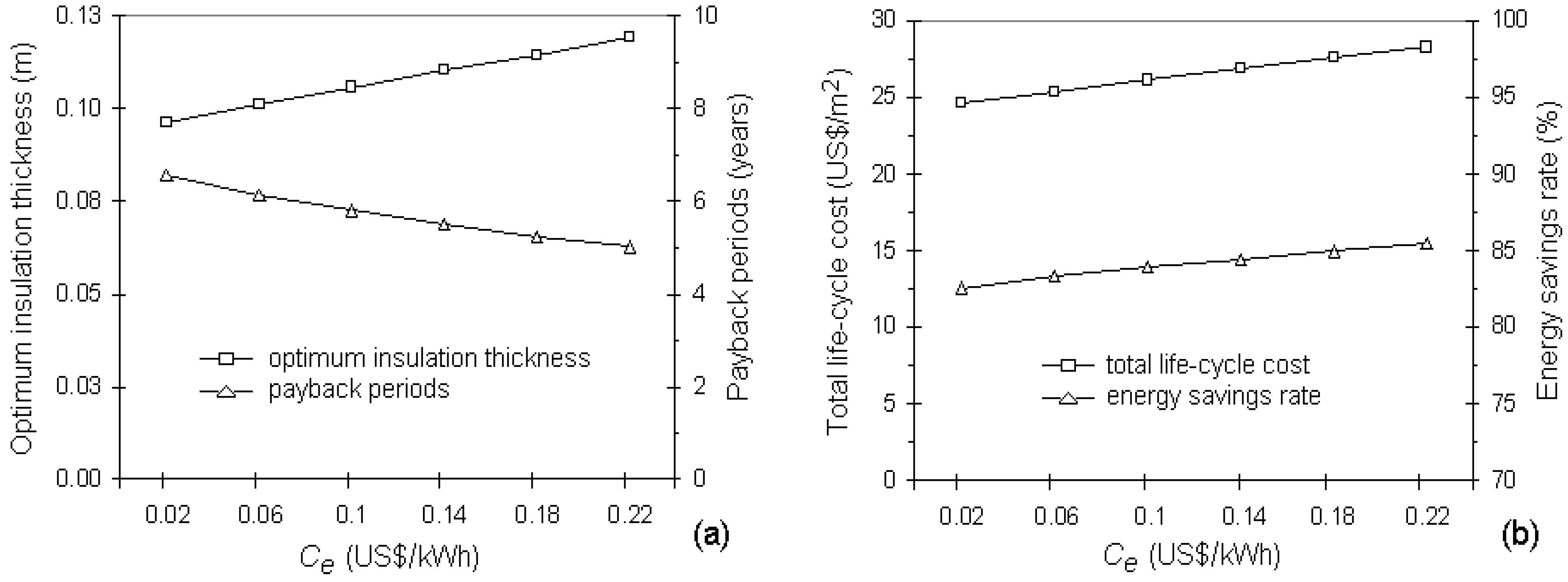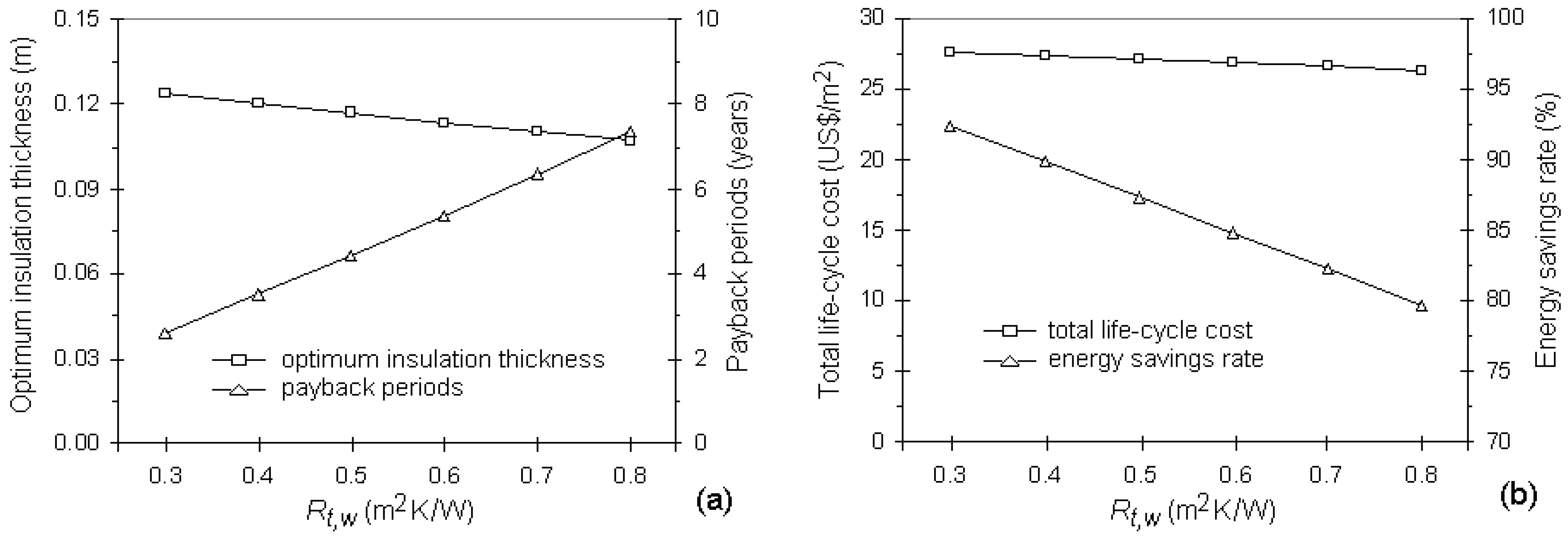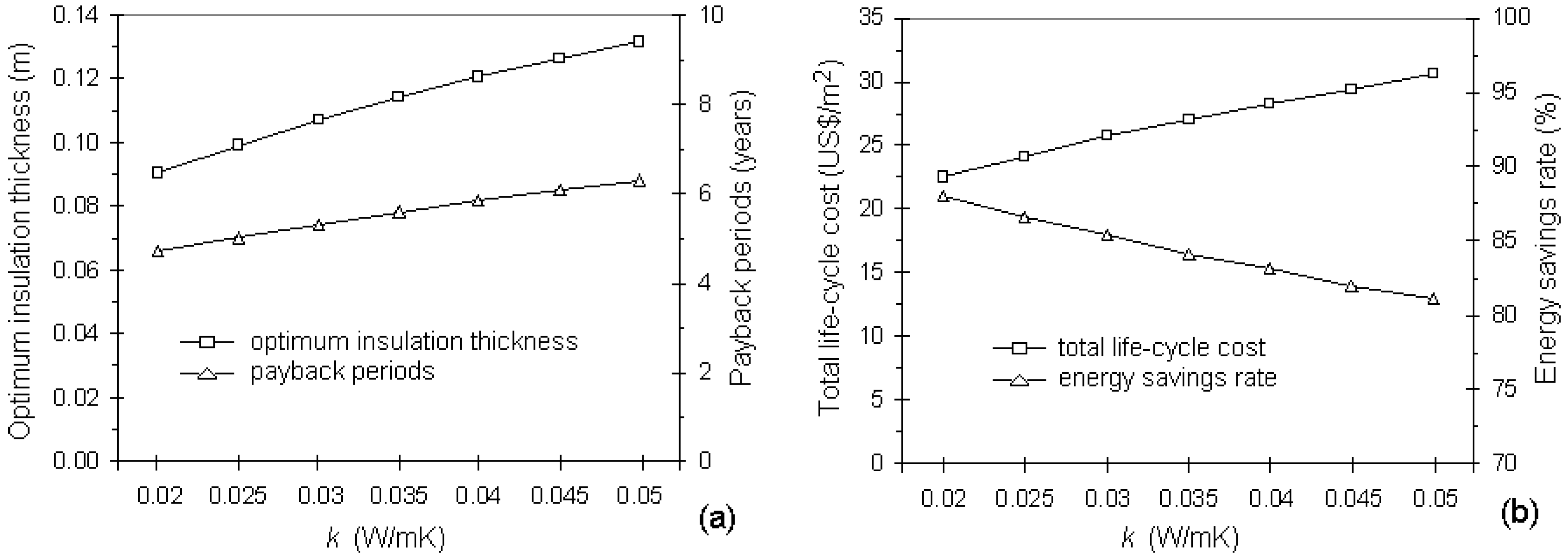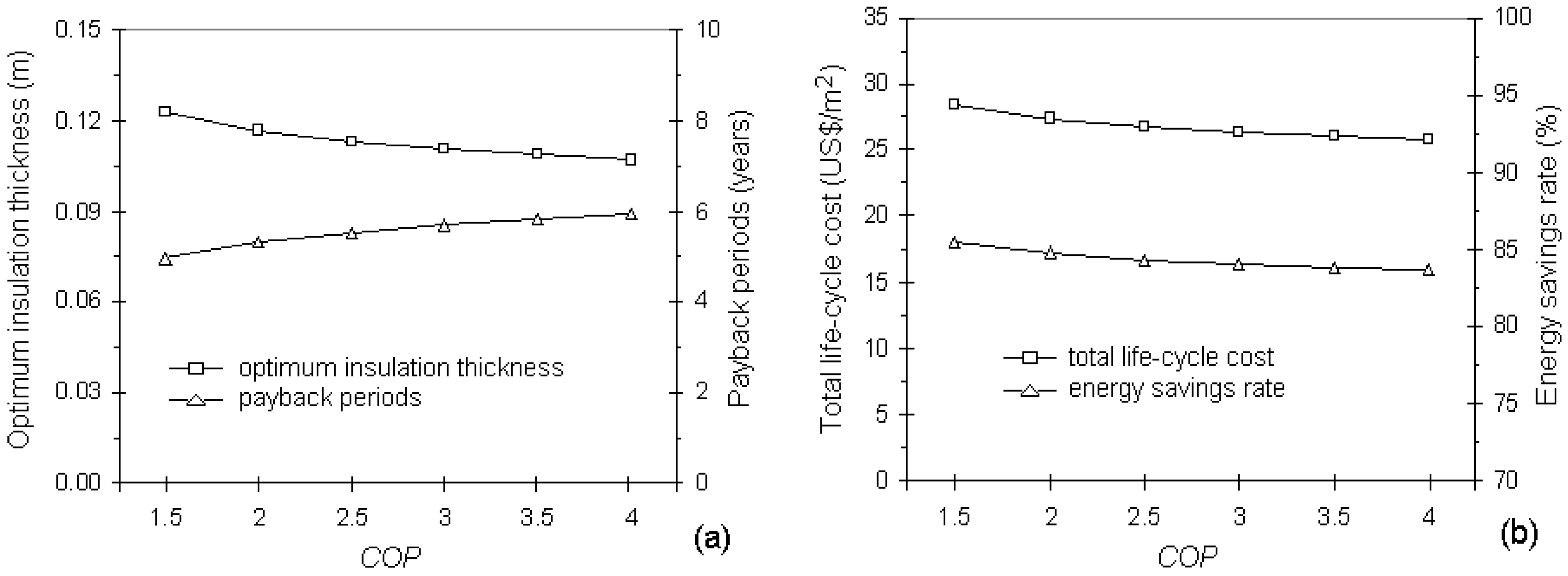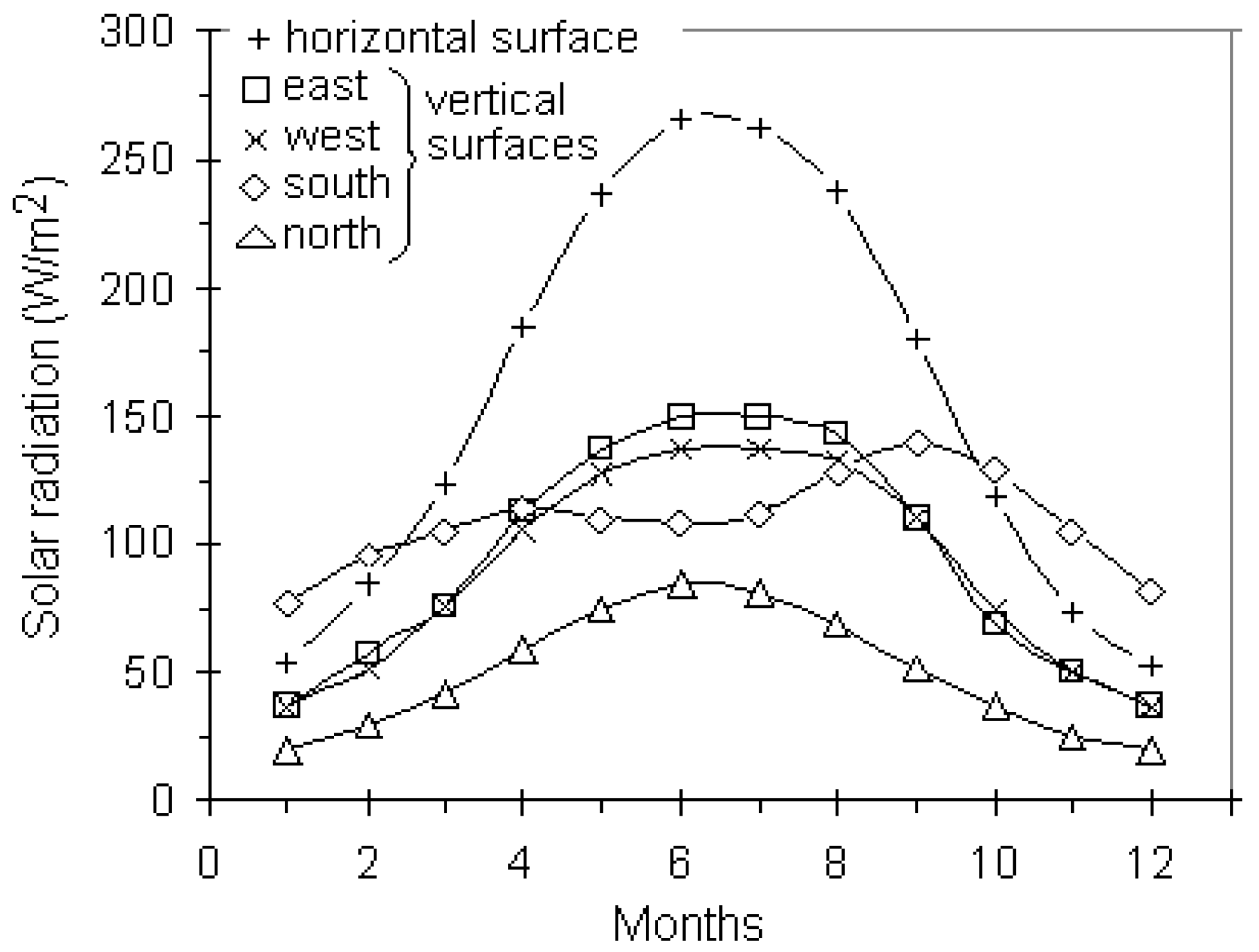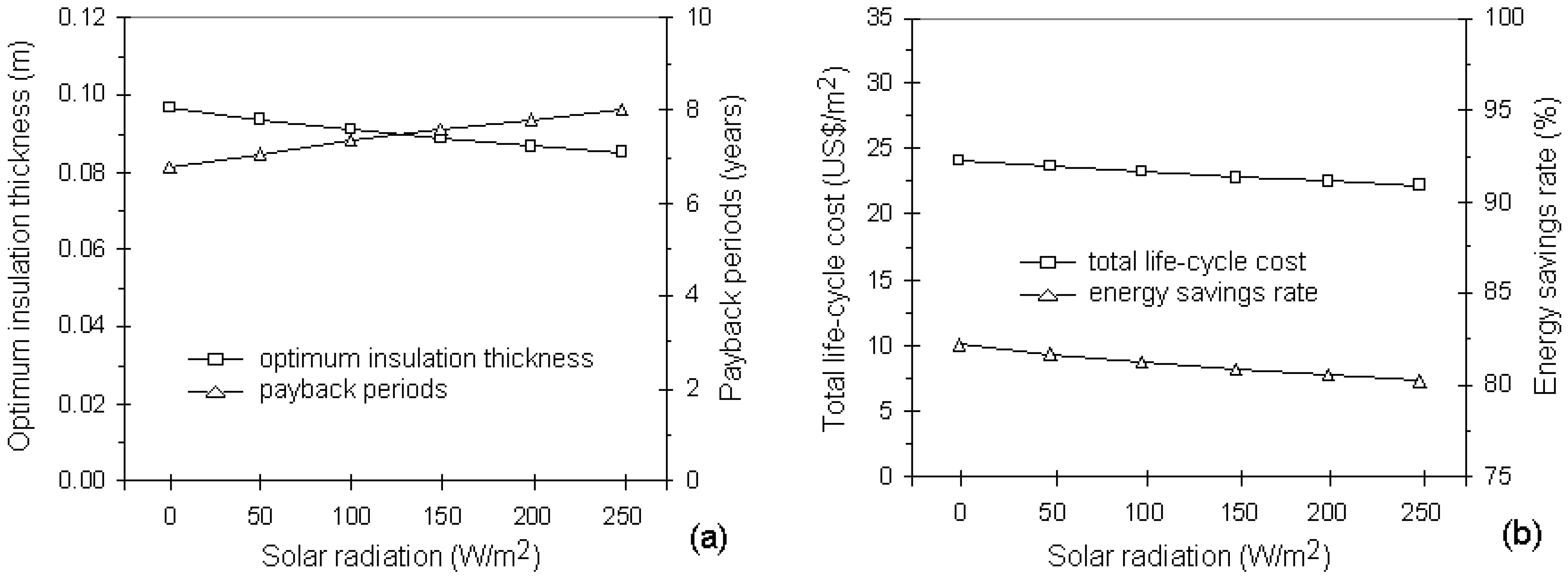1. Introduction
Energy conservation is an increasingly important issue for the residential sector, which accounts for a substantial share of global energy demand (approx. 30–40%) [
1,
2,
3,
4]. Thermal insulation appears to be one of the more valuable tools in achieving energy conservation in buildings, and determining the economic thickness of insulation materials used in building envelopes has become the main goal of many investigations. For that reason, numerous studies have been conducted to optimize the thermal insulation thicknesses based on degree-days.
Using the heating energy required, the optimum insulation thicknesses were calculated based on heating fuel types in [
5,
6,
7] for one or several cities in Turkey. Bolatturk [
8] subsequently investigated the optimum insulation thicknesses and payback periods for seven cities located in the warmest zone in Turkey based on heating and cooling degree-hours (
HDHs and
CDHs). He emphasized that optimizing the insulation thickness with respect to the cooling load was more appropriate for warm regions because the thicknesses of the insulation material (polystyrene) varied between 0.032 and 0.038 m for
CDHs and between 0.016 and 0.027 m for
HDHs. Ucar and Balo [
9] determined the optimum insulation thicknesses depending on principal fuel types used for heating and for four cities located in different
DD regions in Turkey. Similarly, in their more recent study [
10], the insulation thickness only was optimized for certain cities in Turkey based on
HDDs and
CDDs. In that study, four different insulation materials (extruded polystyrene, expanded polystyrene, nil siding, and rock wool) were considered. Comakli and Yuksel [
11] determined the optimum insulation thicknesses for the cities of Erzurum, Kars, and Erzincan located in the cold regions of Turkey, and found that the optimum insulation thicknesses were 0.104, 0.107 and 0.085 m, respectively, for each city when coal was used for heating. In Kaynakli [
12], the variation of the annual heating energy requirement of the building for various architectural design properties (the air inflation rate, the glazing type, and the glazing area) and the optimum insulation thicknesses for different fuel types were investigated. The optimum thicknesses of five insulation materials (expanded polystyrene, extruded polystyrene, foamed polyurethane, perlite, and foamed polyvinyl chloride) were calculated based on
HDDs and
CDDs by Yu
et al. [
13] for a typical residential wall in China. In that study, different wall orientations and surface colors were considered. It was concluded that the optimum insulation thicknesses varied in a wide range, and expanded polystyrene was the most economical insulation material because it had the highest life-cycle savings and the lowest payback period. Another study by Al-Khawaja [
14] considered external wall orientations, in which a comparison of the total costs among three different insulation materials (wallmate, fiberglass, polyethylene foam) was carried out for light-colored and deep-colored surfaces in Qatar, and the sol-air temperature instead of air temperature was used in the analysis.
The studies mentioned above were performed under different climatic conditions, building characteristics, insulation material properties, insulation cost, building lifetime and energy costs. But, detailed parametric analysis has not been carried out on this issue. Daouas [
15] focused only on the economic parameters affecting the optimum insulation thickness.
Different from the above-mentioned studies, all the parameters affecting the optimum thermal insulation thickness for building walls were investigated in this study. The parameters considered in the analysis are, respectively, the heating and cooling DDs, building lifetime, inflation and discount rates, insulation material cost, insulation installation cost, costs of energy sources for heating and cooling (natural gas and electricity), external wall resistance, thermal conductivity of insulation material, coefficient of performance (COP) of the cooling system, and the solar radiation incident on a wall. The influences of these parameters on the optimum insulation thickness, payback periods, total life-cycle cost and energy savings were investigated. In addition, in most studies the effect of solar radiation was not considered in the calculations, which is one of the differences of this study.
2. Mathematical Model
One of the methods to estimate the amount of energy required for heating and cooling which has been used by many authors is to calculate the number of degree-days (
DDs) [
5,
16,
17,
18]. The total number of heating and cooling degree-days (
HDDs and
CDDs) are calculated by:
where
Tb is the base temperature and
To is the daily mean outdoor air temperature. The plus sign above the parentheses indicates that only positive values are to be counted. The total number of
DDs is the sum of the differences between the base temperature and the daily average outside air temperature. Therefore, it is one of the important indicators that reflects the heating or cooling energy requirements of a building. The determination of
Tb depends on various parameters such as climate conditions (e.g., temperature, humidity, precipitation and wind), building characteristics (e.g., thermal insulation, air leakage and solar gains) and personal preferences [
19,
20].
The annual heating and cooling loads per unit area of external wall are given as follows [
8,
10,
13,
16]:
where
η is the efficiency of the heating system,
COP is the coefficient of performance of the cooling system, and
U is the overall heat transfer coefficient expressed as:
In Equation (5),
Rt,w is the total wall thermal resistances excluding the insulation layer, and
x and
k are the thickness and thermal conductivity of insulation material, respectively. The cost of insulation used on an external wall is a function of its thickness. The total insulation cost including the installation cost is given by:
where
Cins is the cost of insulation material per unit volume, and
Cinst is the installation cost. The annual heating (
CH) and cooling (
CC) costs are given by:
where
Hu is the lower heating value of the fuel,
Cf is the cost of fuel,
Ce is the cost of electricity, and
PWF is the present worth factor. The
PWF, which depends upon the lifetime of building (
LT), the inflation rate (
i), and the discount rate (
d), is given as [
21,
22]:
The total annual cost is the sum of the heating and cooling energy costs, and the optimum insulation thickness is obtained by minimizing the total cost. To minimize with respect to insulation thickness, the derivative of the total cost equation is taken and set equal to zero. Therefore, the optimum insulation thickness (
xopt) is obtained as follows:
In several studies (such as Bolatturk [
8], Yu
et al. [
13] and Al-Khawaja [
14]) that considered the heat load from solar radiation on heating and cooling energy requirements, the sol-air temperature was used instead of outdoor air temperature for calculating the
HDDs or
CDDs. The sol-air temperature is a concept related to the outside air temperature and the solar radiative flux, and the temperature considers the incident solar radiation on a wall. The sol-air temperature is given by [
23]:
where
To is the outside air temperature,
αs is the solar absorptivity of the surface,
ho is the combined convection and radiation heat transfer coefficient of the outer surface,
is the solar radiation incident on the surface,
ε is the emissivity of the surface,
σ is the Stefan-Boltzmann constant, and
Tsurr is the temperature of the sky and surrounding surfaces. The details concerning the use of the temperature could be found in [
8,
13,
14,
23,
24,
25].
3. Results and Discussions
The influence of variables affecting the optimization results was investigated under different cases. Predictions were generated by simulating the eleven cases described in
Table 1. In order to investigate the effects of each parameter, while only one parameter was varied, the rest were kept constant, as shown in this table.
HDDs and
CDDs vary in a quite wide range depending on climatic conditions. For example, according to Buyukalaca
et al. [
20], the
HDDs varied between 690 and 5137 for
Tb,h = 18 °C, and
CDDs varied between 0 and 665 for
Tb,c = 24 °C in Turkey. The effects of heating and cooling
DDs on the optimum insulation thickness, payback periods, total life-cycle cost and energy savings are shown in
Figure 1 and
Figure 2. In this analysis, the
HDD and
CDD values varied from 500 to 6000 and from 250 to 2000, respectively, while the other parameters remained constant as shown in
Table 1. As seen in
Figure 1 and
Figure 2, when the heating and cooling energy requirements of a building increased, the thickness of the thermal insulation required also increased. The total cost over the lifetime of 20 years increased with increasing
HDD and
CDD because it included the energy cost. On the other hand, the energy savings rate reached up to 90% by using insulation and the payback period of insulation cost decreased with increasing energy requirements. The payback period dropped from 11 years to 3 years with increasing
HDDs. The payback periods in hot and cold climates were shorter than those in moderate climates. Therefore, applying insulation in climatic conditions having high energy requirements for heating or cooling would be more advantageous.
In the literature, assumptions of
LT varied from 10 years to 30 years (10 years in [
7,
10,
11,
17], 20 years in [
13,
26,
27,
28], 25 years in [
14] and 30 years in [
15,
29,
30]). The influences of
LT on the optimum insulation thickness, payback periods, total life-cycle cost and energy savings are shown in
Figure 3. When the predicted building lifetime increases, thicker insulation should be applied to building walls. This in turn improved the payback period and energy savings.
Table 1.
The parameters used in the analysis and the ranges of variation.
Table 1.
The parameters used in the analysis and the ranges of variation.
| Case | HDD | CDD | LT
years | i/d
% | Cins
$/m3 | Cinst
$/m2 | Cf
$/m3 | Ce
$/kWh | Rt,w
m2K/W | k
W/mK | COP |
W/m2 |
|---|
| 1 | 500–6000 | 500 | 20 | 6/9 | 80 | 7 | 0.4 | 0.135 | 0.617 | 0.034 | 2.5 | 0 |
| 2 | 2000 | 250–2000 | 20 | 6/9 | 80 | 7 | 0.4 | 0.135 | 0.617 | 0.034 | 2.5 | 0 |
| 3 | 2000 | 500 | 5–30 | 6/9 | 80 | 7 | 0.4 | 0.135 | 0.617 | 0.034 | 2.5 | 0 |
| 4 | 2000 | 500 | 20 | 0–10 / 0–10 | 80 | 7 | 0.4 | 0.135 | 0.617 | 0.034 | 2.5 | 0 |
| 5 | 2000 | 500 | 20 | 6/9 | 30–150 | 7 | 0.4 | 0.135 | 0.617 | 0.034 | 2.5 | 0 |
| 6 | 2000 | 500 | 20 | 6/9 | 80 | 0–12 | 0.4 | 0.135 | 0.617 | 0.034 | 2.5 | 0 |
| 7 | 2000 | 500 | 20 | 6/9 | 80 | 7 | 0.2–0.6 | 0.135 | 0.617 | 0.034 | 2.5 | 0 |
| 8 | 2000 | 500 | 20 | 6/9 | 80 | 7 | 0.4 | 0.020–0.220 | 0.617 | 0.034 | 2.5 | 0 |
| 9 | 2000 | 500 | 20 | 6/9 | 80 | 7 | 0.4 | 0.135 | 0.3–0.8 | 0.034 | 2.5 | 0 |
| 10 | 2000 | 500 | 20 | 6/9 | 80 | 7 | 0.4 | 0.135 | 0.617 | 0.020–0.050 | 2.5 | 0 |
| 11 | 2000 | 500 | 20 | 6/9 | 80 | 7 | 0.4 | 0.135 | 0.617 | 0.034 | 1.5–4.0 | 0 |
| 12 | - | - | 20 | 6/9 | 80 | 7 | 0.4 | 0.135 | 0.617 | 0.034 | 2.5 | 0–250 |
Figure 1.
The effects of HDD (a) on optimum thermal insulation thickness and payback period; (b) on total life-cycle cost and energy savings.
Figure 1.
The effects of HDD (a) on optimum thermal insulation thickness and payback period; (b) on total life-cycle cost and energy savings.
Figure 2.
The effects of CDD (a) on optimum thermal insulation thickness and payback period; (b) on total life-cycle cost and energy savings.
Figure 2.
The effects of CDD (a) on optimum thermal insulation thickness and payback period; (b) on total life-cycle cost and energy savings.
Figure 3.
The effects of lifetime (a) on optimum thermal insulation thickness and payback period; (b) on total life-cycle cost and energy savings.
Figure 3.
The effects of lifetime (a) on optimum thermal insulation thickness and payback period; (b) on total life-cycle cost and energy savings.
Figure 4 and
Figure 5 show the effects of particular economic parameters such as inflation and discount rates on the optimum insulation thickness, payback periods, total life-cycle cost and energy savings. The inflation and discount rates were assumed, respectively, as 9.2% and 17.89% in Bolatturk [
5], 4% and 5% in Bolatturk [
8], 4% and 7% in Al-Sanea
et al. [
21], 3% and 4% in Al-Sanea [
31], 8% and 0% in Dombayci
et al. [
7], 9.67% and 19.38% in Ozkan and Onan [
32] and 5% and 8% in Daouas [
15].
As seen in
Figure 4 and
Figure 5, the inflation and discount rates greatly affected the optimum insulation thickness and payback periods. Although the optimum insulation thickness increased with increasing inflation rate, it decreased with increasing discount rate. Similar trends and conclusions were obtained by Daouas [
15] and Al-Sanea and Zedan [
33], confirming the results of the present investigation.
Figure 4.
The effects of inflation rate (a) on optimum thermal insulation thickness and payback period; (b) on total life-cycle cost and energy savings.
Figure 4.
The effects of inflation rate (a) on optimum thermal insulation thickness and payback period; (b) on total life-cycle cost and energy savings.
Figure 5.
The effects of discount rate (a) on optimum thermal insulation thickness and payback period; (b) on total life-cycle cost and energy savings.
Figure 5.
The effects of discount rate (a) on optimum thermal insulation thickness and payback period; (b) on total life-cycle cost and energy savings.
One of the most important parameters affecting the optimum insulation thickness is the cost of thermal insulation material.
Figure 6 and
Figure 7 show the effects of insulation material and installation costs on the optimum insulation thickness, payback periods, total life-cycle cost and energy savings. Typically, the most commonly used insulation materials in the literature are polystyrene (expanded or extruded) and rock wool [
5,
7,
8,
13,
15,
21,
22,
27,
31,
34]. However, polyurethane, fiberglass, and perlite are used in several studies [
9,
13,
14,
21,
27]. According to these studies, the costs of insulation materials varied in a wide range of 24–215 US$/m
3, depending on material types. However, the cost to install the insulation was not considered in the calculations in most studies, such as references [
5,
7,
8,
9,
11,
13,
15,
22,
27,
31,
32,
34]. In Al-Sanea
et al. [
21], the installation cost varied from 0 to 8 US$/m
2 with respect to insulation material types and the configurations of the installed building insulation. When the total cost increased with the insulation material cost, the optimum value of the insulation thickness decreased. Naturally, if the costs of insulation material and installation increased, the payback period increased, as seen in
Figure 6a and
Figure 7a. However, the optimum insulation thickness was not a function of the cost of installation, as seen in Equation (11). For that reason, the optimum value did not change with the cost of installing the insulation. On the other hand, the installation cost greatly affected the payback period. This result clearly showed that the installation cost should be taken into account when evaluating the payback period.
Figure 6.
The effects of thermal insulation cost (a) on optimum thermal insulation thickness and payback period; (b) on total life-cycle cost and energy savings.
Figure 6.
The effects of thermal insulation cost (a) on optimum thermal insulation thickness and payback period; (b) on total life-cycle cost and energy savings.
Figure 7.
The effects of insulation installation cost (a) on optimum thermal insulation thickness and payback period; (b) on total life-cycle cost and energy savings.
Figure 7.
The effects of insulation installation cost (a) on optimum thermal insulation thickness and payback period; (b) on total life-cycle cost and energy savings.
The energy prices for heating and cooling are among the most important factors to determine the optimum insulation thickness and payback period. Compared with coal, fuel-oil, LPG, diesel and kerosene, natural gas was the most widely used energy source for heating in the literature, and electricity was the most widely used for cooling [
8,
13,
14,
15,
21,
27]. The cost of natural gas varied in the range of 0.223–0.4103 US$/m
3 [
7,
32], and the cost of electricity varied in the range of 0.0649–0.21 US$/kWh [
7,
27]. Al-Sanea
et al. [
21] considered the electricity costs in a wide range of 0.013–0.107 US$/kWh (converted by 1 Saudi Riyal (SR) = 3.75 US$). The effects of energy costs on the optimum insulation thickness, payback periods and energy savings are shown in
Figure 8 and
Figure 9. In contrast to the insulation cost, the optimum insulation thickness increased and payback period decreased with increasing the energy costs. In addition, the energy savings rate due to thermal insulation increased with both natural gas and electricity costs.
Figure 8.
The effects of natural gas cost (a) on optimum thermal insulation thickness and payback period; (b) on total life-cycle cost and energy savings.
Figure 8.
The effects of natural gas cost (a) on optimum thermal insulation thickness and payback period; (b) on total life-cycle cost and energy savings.
Figure 9.
The effects of electricity cost (a) on optimum thermal insulation thickness and payback period; (b) on total life-cycle cost and energy savings.
Figure 9.
The effects of electricity cost (a) on optimum thermal insulation thickness and payback period; (b) on total life-cycle cost and energy savings.
Because the studies related to thermal insulation thickness for building walls were carried out in different geographical regions, such as Qatar [
14], Palestine [
22], Turkey [
5,
7,
8,
11,
32,
34], Tunisia [
15], Saudi Arabia [
21,
31], Maldives [
26], and China [
13], the external wall resistances used in the optimization process varied in the range of 0.307–0.945 m
2K/W depending on wall structure and type. Similarly, the thermal conductivity of insulating materials in the literature varied in the range of 0.021–0.054 W/mK depending on material types (such as extruded polystyrene, expanded polystyrene, polyurethane, fiberglass, and rock wool ) and properties (such as density) [
13,
27]. The effects of external wall resistance excluding the insulation layer and the thermal conductivity of the insulation material are given in
Figure 10 and
Figure 11, respectively. An increase in the thermal conductivity of the insulation decreased the total resistance, which increased the total cost over the building lifetime of 20 years and the required insulation thickness. Because of the same situation, an increase in the wall resistance decreased the optimum insulation thickness.
Figure 10.
The effects of wall resistance excluding the insulation layer (a) on optimum thermal insulation thickness and payback period; (b) on total life-cycle cost and energy savings.
Figure 10.
The effects of wall resistance excluding the insulation layer (a) on optimum thermal insulation thickness and payback period; (b) on total life-cycle cost and energy savings.
Figure 11.
The effects of thermal conductivity of insulation (a) on optimum thermal insulation thickness and payback period; (b) on total life-cycle cost and energy savings.
Figure 11.
The effects of thermal conductivity of insulation (a) on optimum thermal insulation thickness and payback period; (b) on total life-cycle cost and energy savings.
The
COP of the cooling system depends on the operating conditions of the system. On average, it was assumed to be 2 in Al-Khawaja [
14], 2.3 in Yu
et al. [
13], 2.5 in Bolatturk [
8], 2.93 in Mahlia
et al. [
27] and Daouas [
15], 3 in Al-Sanea
et al. [
21] and Al-Sanea
et al. [
31].
Figure 12 shows the influences of
COP. Because the system efficiency improved with increasing
COP values, the cooling cost, and thus the total cost, decreased. However, the value of
COP did not affect the optimum insulation thickness as significantly as the other parameters because it only affected the cooling cost.
Solar radiation has a significant effect on the heating and cooling loads of a building. The effect of solar radiation on the optimum insulation thickness was investigated by Bolatturk [
8], Yu
et al. [
13] and Al-Khawaja [
14]. In these studies, the
DD values were calculated by considering the solar-air temperature. In the present study, which was performed in Istanbul, Turkey (41°N latitude, 29°E longitude and 39 m altitude), the variation of the monthly average daily solar radiation on a surface was calculated, and the results are shown in
Figure 13. Details of the calculation method can be found in Duffie and Bechman [
35] and Yigit and Atmaca [
36]. The incoming solar radiation incident on a wall varies with geographic latitudes and wall orientations. As seen in
Figure 13, the total solar radiation incident on a horizontal surface was generally higher than that on vertical surfaces over the year, which reached 250 W/m
2 in the summer months. Among the vertical surfaces, the south-facing surface received more stable solar radiation during the year (in the range of 80–140 W/m
2), and the north-facing surface received less solar radiation during the year (max. 85 W/m
2). The effects of solar radiation in the range of 0–250 W/m
2 are shown in
Figure 14. Because the
HDD and
CDD values varied with the amount of incoming solar radiation on a surface, these values were not given in
Table 1 for the Case 12. While the solar radiation reduced the heating load, it increased the cooling load. However, the overall effect decreased the total energy (heating + cooling) cost and the optimum insulation thickness.
Figure 12.
The effects of COP of cooling system (a) on optimum thermal insulation thickness and payback period; (b) on total life-cycle cost and energy savings.
Figure 12.
The effects of COP of cooling system (a) on optimum thermal insulation thickness and payback period; (b) on total life-cycle cost and energy savings.
Figure 13.
Total solar radiation on horizontal and vertical surfaces with different orientations in Istanbul.
Figure 13.
Total solar radiation on horizontal and vertical surfaces with different orientations in Istanbul.
Figure 14.
The effects of solar radiation incident on a surface (a) on optimum thermal insulation thickness and payback period; (b) on total life-cycle cost and energy savings.
Figure 14.
The effects of solar radiation incident on a surface (a) on optimum thermal insulation thickness and payback period; (b) on total life-cycle cost and energy savings.
4. Conclusions
This study has presented the results of a parametric analysis which is carried out to investigate the effect of various parameters on the optimum insulation thickness for external walls by considering payback period, total cost and energy savings. The investigated parameters in this analysis are, respectively, the heating and cooling DDs, building lifetime, inflation and discount rates, cost of insulation material, cost to install the insulation, costs of energy sources for heating and cooling (specifically natural gas and electricity), total wall resistance, thermal conductivity of the insulation, COP, and the solar radiation.
The parameters considered in this study are in the range of values typically reported in the literature. According to obtained results, the parameters that increase the optimum thermal insulation thickness are HDD, CDD, lifetime, inflation rate, natural gas cost, electricity cost, and thermal conductivity. However, the parameters that decrease the optimum thermal insulation thickness are discount rate, insulation material cost, total wall resistance excluding the insulation, COP, and the incoming solar radiation on a wall. Furthermore, the payback period increases with increasing discount rate, insulation cost, insulation installation cost, thermal conductivity of insulation, total wall resistance, and COP.
This study has also showed that the parameters having the most significant effect on optimizing the thermal insulation thickness are the energy requirements, LT of building and the insulation cost, however, the electricity cost, wall resistance, thermal conductivity of insulation, COP and solar radiation have found to be relatively less effective.
